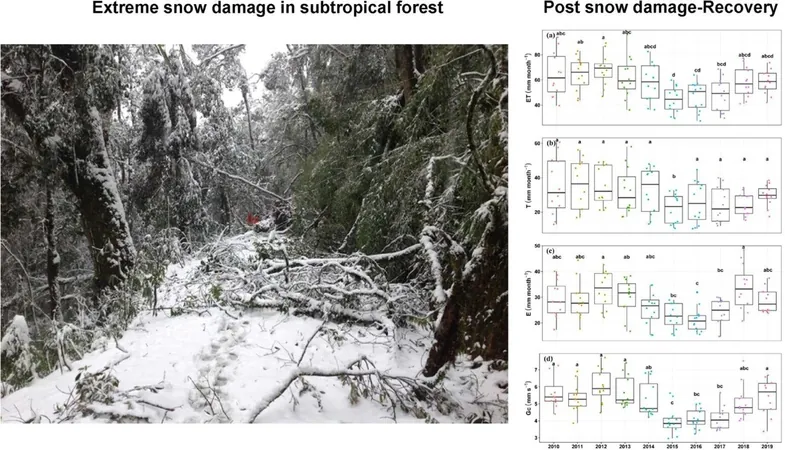
Unraveling the Secrets of Forest Resilience: How a Snow Disaster Rejuvenates Subtropical Ecosystems
2024-09-27
Author: Emily
Introduction
Forests are not just beautiful landscapes; they are vital components of the global water cycle. Yet, the intricate details of how these ecosystems bounce back from natural disasters have remained a mystery. Recent research led by scientists from the Xishuangbanna Tropical Botanical Garden (XTBG) of the Chinese Academy of Sciences sheds light on this intriguing phenomenon.
Research Overview
Their groundbreaking study, recently published in the Journal of Hydrology: Regional Studies, focuses on the Ailaoshan Mountain National Nature Reserve—a crucial water catchment area for the Lancang River basin and a subtropical ecological jewel in Southwestern China. After a devastating snowfall in 2015 that wreaked havoc on vegetation, the researchers aimed to understand the resilience of evapotranspiration, or the process by which water evaporates from soil and transpires from plants.
Key Questions
The question remained: how do subtropical forests respond to such extreme weather events, and what does their recovery process look like over the years that follow? The researchers turned to eddy covariance data collected from 2010 to 2019, meticulously analyzing the effects of this snow disaster on forest water fluxes.
Significant Findings
The results were striking. The heavy snow led to a staggering 49% decrease in the leaf area index (LAI) during the disaster year. Consequently, critical processes such as evapotranspiration, transpiration, evaporation, and canopy conductance suffered significant reductions of 35%, 36%, 23%, and 33%, respectively. But here's the twist: while transpiration bounced back quickly in 2016 due to a surge in understory vegetation growth, evaporation and canopy conductance lagged behind, not recovering until 2018.
Ecological Implications
This delayed recovery of evaporation proved to have its benefits: it allowed for the accumulation of water storage within the ecosystem, aiding in the robust growth of understory plants through increased transpiration. Such dynamics provided essential stability within the ecosystem, enhancing its overall resilience to future disturbances.
Conclusion
“Our findings offer crucial insights into the adaptive capacity of forest ecosystems in the face of climate change,” stated Song Qinghai, the lead author of the study. This research illuminates not just a specific case in the Ailaoshan Mountains, but also serves as a bellwether for forests around the globe as they navigate the challenges posed by extreme weather events.
In summary, the study underscores the notion that not all impacts of climate-induced damages are unequivocally negative; rather, some may catalyze positive change in the long run, fostering stability and resilience in subtropical forests. As climate change intensifies, understanding these dynamics will be essential for ensuring the health and sustainability of forest ecosystems worldwide.









 Brasil (PT)
Brasil (PT)
 Canada (EN)
Canada (EN)
 Chile (ES)
Chile (ES)
 Česko (CS)
Česko (CS)
 대한민국 (KO)
대한민국 (KO)
 España (ES)
España (ES)
 France (FR)
France (FR)
 Hong Kong (EN)
Hong Kong (EN)
 Italia (IT)
Italia (IT)
 日本 (JA)
日本 (JA)
 Magyarország (HU)
Magyarország (HU)
 Norge (NO)
Norge (NO)
 Polska (PL)
Polska (PL)
 Schweiz (DE)
Schweiz (DE)
 Singapore (EN)
Singapore (EN)
 Sverige (SV)
Sverige (SV)
 Suomi (FI)
Suomi (FI)
 Türkiye (TR)
Türkiye (TR)
 الإمارات العربية المتحدة (AR)
الإمارات العربية المتحدة (AR)